8.3E: Exercises
- Page ID
- 120499
\( \newcommand{\vecs}[1]{\overset { \scriptstyle \rightharpoonup} {\mathbf{#1}} } \)
\( \newcommand{\vecd}[1]{\overset{-\!-\!\rightharpoonup}{\vphantom{a}\smash {#1}}} \)
\( \newcommand{\id}{\mathrm{id}}\) \( \newcommand{\Span}{\mathrm{span}}\)
( \newcommand{\kernel}{\mathrm{null}\,}\) \( \newcommand{\range}{\mathrm{range}\,}\)
\( \newcommand{\RealPart}{\mathrm{Re}}\) \( \newcommand{\ImaginaryPart}{\mathrm{Im}}\)
\( \newcommand{\Argument}{\mathrm{Arg}}\) \( \newcommand{\norm}[1]{\| #1 \|}\)
\( \newcommand{\inner}[2]{\langle #1, #2 \rangle}\)
\( \newcommand{\Span}{\mathrm{span}}\)
\( \newcommand{\id}{\mathrm{id}}\)
\( \newcommand{\Span}{\mathrm{span}}\)
\( \newcommand{\kernel}{\mathrm{null}\,}\)
\( \newcommand{\range}{\mathrm{range}\,}\)
\( \newcommand{\RealPart}{\mathrm{Re}}\)
\( \newcommand{\ImaginaryPart}{\mathrm{Im}}\)
\( \newcommand{\Argument}{\mathrm{Arg}}\)
\( \newcommand{\norm}[1]{\| #1 \|}\)
\( \newcommand{\inner}[2]{\langle #1, #2 \rangle}\)
\( \newcommand{\Span}{\mathrm{span}}\) \( \newcommand{\AA}{\unicode[.8,0]{x212B}}\)
\( \newcommand{\vectorA}[1]{\vec{#1}} % arrow\)
\( \newcommand{\vectorAt}[1]{\vec{\text{#1}}} % arrow\)
\( \newcommand{\vectorB}[1]{\overset { \scriptstyle \rightharpoonup} {\mathbf{#1}} } \)
\( \newcommand{\vectorC}[1]{\textbf{#1}} \)
\( \newcommand{\vectorD}[1]{\overrightarrow{#1}} \)
\( \newcommand{\vectorDt}[1]{\overrightarrow{\text{#1}}} \)
\( \newcommand{\vectE}[1]{\overset{-\!-\!\rightharpoonup}{\vphantom{a}\smash{\mathbf {#1}}}} \)
\( \newcommand{\vecs}[1]{\overset { \scriptstyle \rightharpoonup} {\mathbf{#1}} } \)
\( \newcommand{\vecd}[1]{\overset{-\!-\!\rightharpoonup}{\vphantom{a}\smash {#1}}} \)
In Exercises 1 - 8, sketch the graph of the given parabola. Find the vertex, focus and directrix. Include the endpoints of the latus rectum in your sketch.
- \((x - 3)^{2} = -16y\)
- \(\left(x + \frac{7}{3}\right)^{2} = 2\left(y + \frac{5}{2}\right)\)
- \((y - 2)^{2} = -12(x + 3)\)
- \((y + 4)^{2} = 4x\)
- \((x-1)^2 = 4(y+3)\)
- \((x+2)^2 = -20(y-5)\)
- \((y-4)^2 = 18(x-2)\)
- \(\left(y+ \frac{3}{2}\right)^2 = -7 \left(x+ \frac{9}{2}\right)\)
In Exercises 9 - 14, put the equation into standard form and identify the vertex, focus and directrix.
- \(y^{2} - 10y - 27x + 133 = 0\)
- \(25x^{2} + 20x + 5y - 1 = 0\)
- \(x^2 + 2x - 8y + 49 = 0\)
- \(2y^2 + 4y +x - 8 = 0\)
- \(x^2-10x+12y+1=0\)
- \(3y^2-27y+4x+\frac{211}{4} = 0\)
In Exercises 15 - 18, find an equation for the parabola which fits the given criteria.
- Vertex \((7, 0)\), focus \((0, 0)\)
- Focus \((10, 1)\), directrix \(x = 5\)
- Vertex \((-8, -9)\); \((0, 0)\) and \((-16, 0)\) are points on the curve
- The endpoints of latus rectum are \((-2, -7)\) and \((4, -7)\)
- The mirror in Carl’s flashlight is a paraboloid of revolution. If the mirror is 5 centimeters in diameter and 2.5 centimeters deep, where should the light bulb be placed so it is at the focus of the mirror?
- A parabolic Wi-Fi antenna is constructed by taking a flat sheet of metal and bending it into a parabolic shape.5 If the cross section of the antenna is a parabola which is 45 centimeters wide and 25 centimeters deep, where should the receiver be placed to maximize reception?
- [parabolaarch] A parabolic arch is constructed which is 6 feet wide at the base and 9 feet tall in the middle. Find the height of the arch exactly 1 foot in from the base of the arch.
- A popular novelty item is the ‘mirage bowl.’ Follow this link to see another startling application of the reflective property of the parabola.
- With the help of your classmates, research spinning liquid mirrors. To get you started, check out this website.
7.3.2. Answers
-
\((x - 3)^{2} = -16y\)
Vertex \((3, 0)\)
Focus \((3, -4)\)
Directrix \(y = 4\)
Endpoints of latus rectum \((-5, -4)\), \((11, -4)\)
-
\(\left(x + \frac{7}{3}\right)^{2} = 2\left(y + \frac{5}{2}\right)\)
Vertex \(\left(-\frac{7}{3}, -\frac{5}{2} \right)\)
Focus \(\left(-\frac{7}{3}, -2 \right)\)
Directrix \(y = -3\)
Endpoints of latus rectum \(\left(-\frac{10}{3}, -2 \right)\), \(\left(-\frac{4}{3}, -2 \right)\)
-
\((y - 2)^{2} = -12(x + 3)\)
Vertex \((-3, 2)\)
Focus \((-6, 2)\)
Directrix \(x = 0\)
Endpoints of latus rectum \((-6, 8)\), \((-6, -4)\)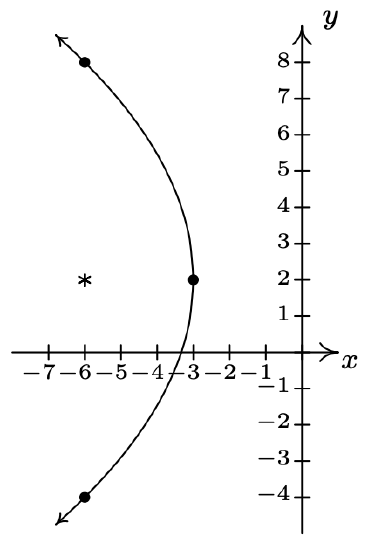
-
\((y + 4)^{2} = 4x\)
Vertex \((0,-4)\)
Focus \((1,-4)\)
Directrix \(x = -1\)
Endpoints of latus rectum \((1, -2)\), \((1, -6)\)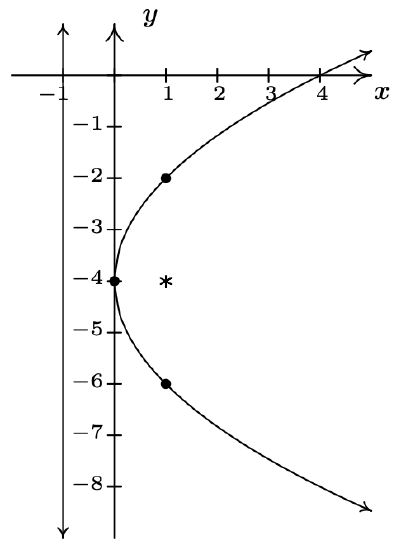
-
\((x-1)^2 = 4(y+3)\)
Vertex \(\left(1, -3\right)\)
Focus \(\left(1, -2 \right)\)
Directrix \(y = -4\)
Endpoints of latus rectum \(\left(3, -2 \right)\), \(\left(-1, -2 \right)\)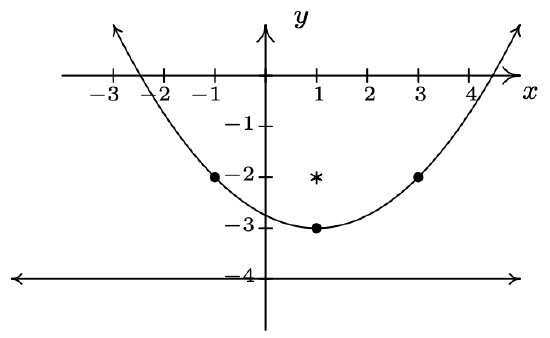
-
\((x+2)^2 = -20(y-5)\)
Vertex \(\left(-2, 5\right)\)
Focus \(\left(-2, 0 \right)\)
Directrix \(y = 10\)
Endpoints of latus rectum \(\left(-12, 0 \right)\), \(\left(8, 0 \right)\)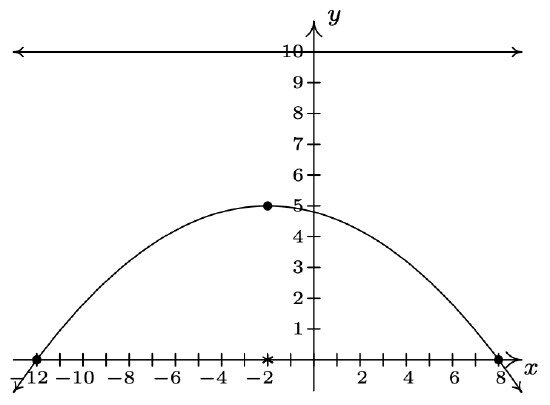
-
\((y-4)^2 = 18(x-2)\)
Vertex \(\left(2, 4\right)\)
Focus \(\left( \frac{13}{2}, 4 \right)\)
Directrix \(x = -\frac{5}{2}\)
Endpoints of latus rectum \(\left(\frac{13}{2}, -5 \right)\), \(\left(\frac{13}{2}, 13 \right)\)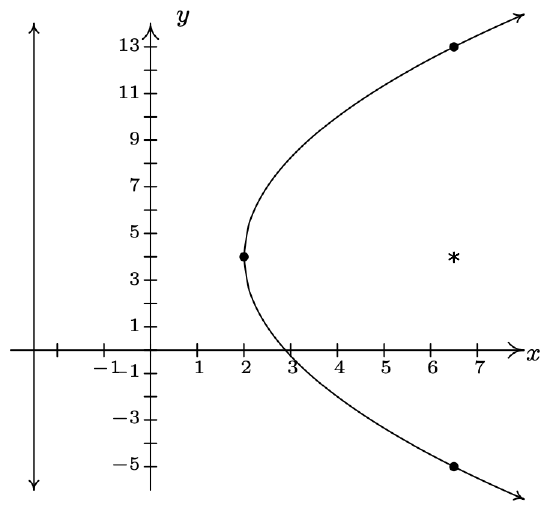
-
\(\left(y+ \frac{3}{2}\right)^2 = -7 \left(x+ \frac{9}{2}\right)\)
Vertex \(\left(-\frac{9}{2}, -\frac{3}{2}\right)\)
Focus \(\left( -\frac{25}{4}, -\frac{3}{2} \right)\)
Directrix \(x = -\frac{11}{4}\)
Endpoints of latus rectum \(\left(-\frac{25}{4}, 2 \right)\), \(\left(-\frac{25}{4}, -5 \right)\)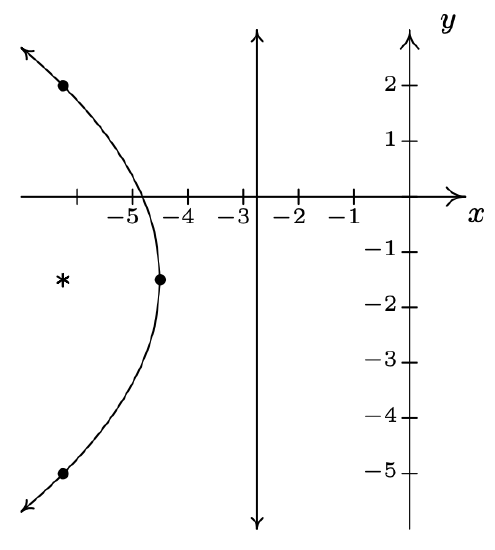
-
\((y - 5)^{2} = 27(x - 4)\)
Vertex \((4, 5)\)
Focus \(\left( \frac{43}{4}, 5 \right)\)
Directrix \(x = -\frac{11}{4}\) -
\(\left(x + \frac{2}{5} \right)^{2} = -\frac{1}{5}(y - 1)\)
Vertex \(\left( -\frac{2}{5}, 1 \right)\)
Focus \(\left( -\frac{2}{5}, \frac{19}{20} \right)\)
Directrix \(y = \frac{21}{20}\) -
\((x+1)^2=8(y-6)\)
Vertex \((-1,6)\)
Focus \((-1,8)\)
Directrix \(y=4\) -
\((y+1)^2=-\frac{1}{2}(x-10)\)
Vertex \((10,-1)\)
Focus \(\left(\frac{79}{8}, -1 \right)\)
Directrix \(x = \frac{81}{8}\) -
\((x-5)^2 = -12(y-2)\)
Vertex \((5,2)\)
Focus \((5,-1)\)
Directrix \(y=5\) -
\(\left(y-\frac{9}{2}\right)^2 = -\frac{4}{3} (x-2)\)
Vertex \(\left(2, \frac{9}{2}\right)\)
Focus \(\left(\frac{5}{3}, \frac{9}{2}\right)\)
Directrix \(x = \frac{7}{3}\) - \(y^{2} = -28(x - 7)\)
- \((y - 1)^{2} = 10\left(x - \frac{15}{2} \right)\)
- \((x + 8)^{2} = \frac{64}{9}(y + 9)\)
-
\((x - 1)^{2} = 6\left(y + \frac{17}{2}\right)\) or
\((x - 1)^{2} = -6\left(y + \frac{11}{2}\right)\) - The bulb should be placed \(0.625\) centimeters above the vertex of the mirror. (As verified by Carl himself!)
- The receiver should be placed \(5.0625\) centimeters from the vertex of the cross section of the antenna.
- The arch can be modeled by \(x^2=-(y-9)\) or \(y=9-x^2\). One foot in from the base of the arch corresponds to either \(x = \pm 2\), so the height is \(y=9-(\pm 2)^2=5\) feet.

